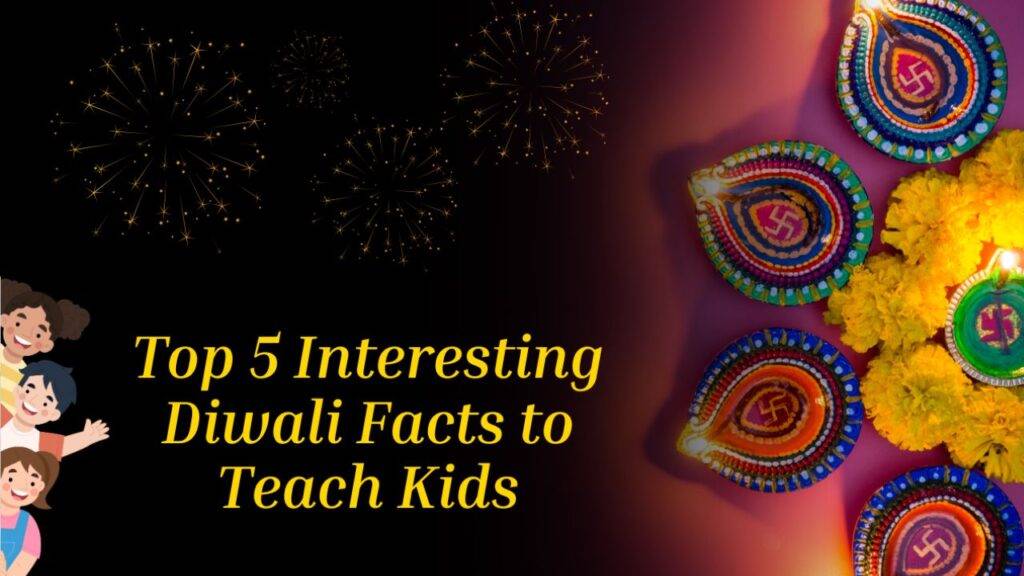Diwali, the Festival of Lights, is one of the most loved and celebrated festivals in India. It’s a time filled with joy, vibrant colors, and festive lights that brighten up homes and hearts. But there’s much more to Diwali than just sweets, fireworks, and decorations.
It’s a festival rich in culture, history, and meaning—perfect for teaching kids about tradition in a fun and engaging way. In this blog post, let’s explore five interesting facts about Diwali that will not only educate kids but also spark their curiosity.
1. The Story Behind Diwali – A Victory of Good Over Evil
Diwali celebrates the victory of good over evil, but do you know the story behind it? The festival is largely based on the ancient Hindu epic Ramayana. According to the story, Lord Rama, the prince of Ayodhya, returned home after 14 years of exile. During this time, he fought and defeated the evil king Ravana, who had kidnapped his wife, Sita.
Also Read: Diwali Celebration Ideas for Schools
The people of Ayodhya celebrated Lord Rama’s return by lighting oil lamps (called diyas) to welcome him back. This tradition of lighting diyas continues even today and symbolizes the victory of light over darkness and good over evil. Teaching kids this beautiful story can help them understand the deeper meaning of Diwali.
2. Diwali is Celebrated by Multiple Religions
While Diwali is most commonly associated with Hinduism, what many don’t know is that it is celebrated by people of different religions across India and beyond. Each community has its own reason for celebrating Diwali:
- Hindus: Celebrate the return of Lord Rama to Ayodhya.
- Sikhs: Mark the release of the sixth Guru, Guru Hargobind Ji, from prison. Another name for this day is Bandi Chhor Divas.
- Jains: Celebrate the day when Lord Mahavira, the last Tirthankara (spiritual teacher), attained Nirvana (spiritual enlightenment).
- Buddhists: Some Buddhists, particularly the Newar Buddhists of Nepal, celebrate Diwali as a day of honor to Emperor Ashoka, who converted to Buddhism.
By teaching kids that Diwali transcends religions, we can show them the importance of unity in diversity.
3. The Festival Lasts for Five Days
Diwali is not just a one-day event—it’s a five-day-long celebration, each day having its own special meaning and rituals. Here’s a quick breakdown of the five days of Diwali:
- Day 1: Dhanteras: The first day marks the beginning of the festival. To bring luck, people purchase new kitchenware, gold, or silver.
- Day 2: Naraka Chaturdashi or Chhoti Diwali: On this day, people cleanse their homes and themselves, preparing for the main Diwali day.
- Day 3: Diwali: The main event! Homes are lit with diyas, and families perform Lakshmi Puja to invite wealth and prosperity.
- Day 4: Govardhan Puja: This day is dedicated to Lord Krishna, who is believed to have saved the people of Gokul from a massive flood.
- Day 5: Bhai Dooj: This day celebrates the bond between brothers and sisters, similar to Raksha Bandhan.
When teaching kids about Diwali, telling them that it’s a five-day-long celebration can keep their excitement going for the entire duration of the festival! In Dr. Kishore’s Ratnam Schools in Nellore, Kavali, Tirupati & Srikalahasti has mastered the art of imbibing the seed of culture amongst children.
4. Diwali is Celebrated Worldwide
Diwali isn’t just celebrated in India; it’s observed by millions of people around the world! Countries with large Indian populations, such as Nepal, Sri Lanka, Malaysia, Singapore, and Fiji, also celebrate Diwali with great enthusiasm. But the festival doesn’t stop there. In cities like London, New York, Sydney, and Dubai, you can find big Diwali events with firework displays, food festivals, and cultural programs.
Also Read: Eco-Friendly Diwali Activities to Save the Environment
Kids will be fascinated to learn how a festival from India is now celebrated globally, showing them that cultures and traditions can spread joy across borders.
5. Rangoli – An Art Form Made of Colors
A Diwali fact that kids will find fun and creative is the tradition of making Rangoli. Rangoli is a beautiful, colorful design made on the ground, usually at the entrance of homes, using colored powders, flowers, or rice. Simple patterns to elaborate artwork are all included in these designs.
Also Read: Eco-Friendly Rangoli Designs for Diwali Celebrations
The purpose of Rangoli is to welcome Goddess Lakshmi, the goddess of wealth and prosperity, into homes. It is also believed to bring good prosperity. Rangoli designs often include symbols like flowers, diyas, and peacocks, making it a fun activity for kids to try at home.
By involving kids in making Rangoli, you can let them express their creativity while learning about an important Diwali tradition.
Bonus Fact: The Science Behind Firecrackers
While firecrackers are a big part of Diwali celebrations, it’s interesting to teach kids about the science behind them! Firecrackers work through a combination of chemicals that create loud noises and bright colors when ignited. But did you know different metals create different colors in fireworks? For example:
- Copper creates blue.
- Barium produces green.
- Sodium brings yellow.
This can be a great way to introduce kids to chemistry in a fun and festive manner. However, it’s also essential to educate them about the environmental impact of fireworks and encourage the use of eco-friendly alternatives like laser shows or quieter fireworks.
Conclusion
Diwali is more than just a light festival. It is a celebration filled with history, unity, art, and science, offering a perfect opportunity for kids to learn and have fun. By teaching them these fascinating facts, you can help them appreciate the deeper meaning of the festival and its many traditions.
So, next time you’re getting ready to celebrate Diwali with your family, try sharing these interesting facts with your kids. Who knows, they might enjoy the festival even more!


